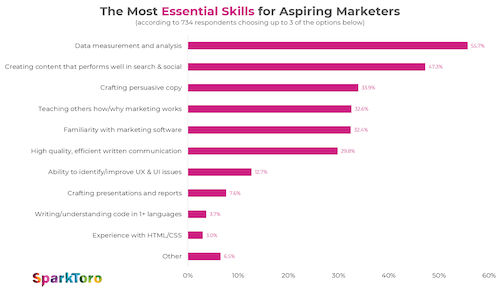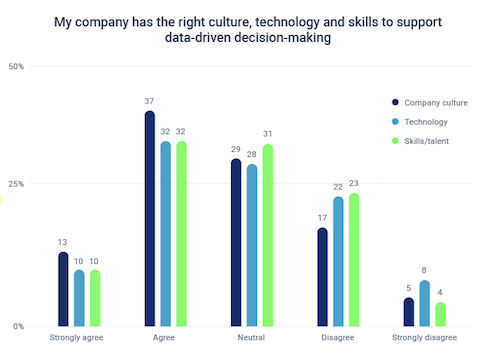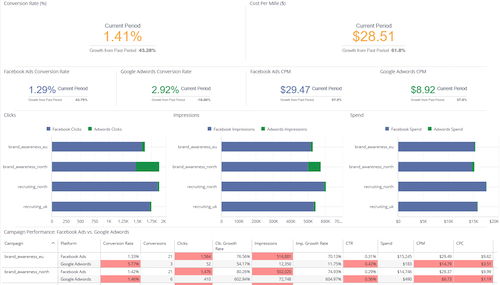
Editor’s Note: This guest post was contributed by Barry Feldman, Owner of Feldman Creative.
The phrase “data-driven marketing” has been bounced around for so long it now sounds cliché. But still, and importantly, reliance on marketing analytics and the number of firms using quantitative tools continues to rise, as indicated by Research from The CMO Survey.
However, the ability to master it appears to be forever evasive. Only 19% of marketers claim to possess a high level of “data literacy” skills, according to MyNewsDesk. Look at this:

SparkToro conducted research on marketing hiring practices which revealed data measurement and analysis now ranks as the most essential skill for getting hired in marketing.
What’s Data Literacy?
MyNewsDesk defines data literacy simply as, “the ability to extract meaning and insights from data.” Rahul Bhargava and Catherine D’ignazio, from MIT, extend the definition as, “the ability to read, work with, analyze, and argue with data.” They say data literacy is a skill that empowers workers to ask the right questions, build knowledge, make decisions and communicate meaning to others.

The Date-Driven Mindset, a research report from MyNewsDesk and Mention includes data that shows just a fraction strongly agree they have the culture, technology and skills to support data-driven decision-making and those that agree at all still represent a minority.
Data Literacy Begins With Company Culture
Data literacy is not just for the scientists among us.
In today’s data-driven marketing world, companies must create a culture that encourages the use of data to support decision-making. Companies that have created and nurture a data literate culture don’t just look back but use data to predict customer behavior—and attempt to influence it. Marketers explore data and experiment with it to uncover new opportunities.
Clearly, recruitment now plays a key role. Companies need to focus on hiring employees who champion data-driven decision-making. Though numerous roles may not require supreme data science skills, data literate employees are far better equipped to participate in and contribute to the data economy.
Tips for Building Data Literacy
However valuable marketing analytics may be, according to Forbes Council Member Charlie Grinnel, “Many professionals still resist it for a variety of reasons whether they’re intimidated or simply not interested.”
Here are some valuable tips for building data literacy:
- Understand data is the quantification of human behavior. The most consumer-centric brands understand marketing analytics is simply the quantification of human behavior.
- Include data literacy in employee training. Provide relevant resources into your regular employee training processes. Ensure you employees understand the benefits of being data-driven.
- Share your marketing metrics. Have members of your team share their take-aways in meetings. Invite each to take a few minutes to present high-level metrics and what they mean. Everyone on your team becomes more data-aware and informed.
- Look to experts for guidance. Encourage everyone to grow their data literacy by learning from professionals. Try to connect and converse with leaders in the organization or industry. Take an online course. And, of course, follow noted and relevant experts via social media and blogs.
Tips for Building Data Literacy
However valuable marketing analytics may be, according to Forbes Council Member Charlie Grinnel, “Many professionals still resist it for a variety of reasons whether they’re intimidated or simply not interested.”
Here are some valuable tips for building data literacy:
- Understand data is the quantification of human behavior. The most consumer-centric brands understand marketing analytics is simply the quantification of human behavior.
- Include data literacy in employee training. Provide relevant resources into your regular employee training processes. Ensure you employees understand the benefits of being data-driven.
- Share your marketing metrics. Have members of your team share their take-aways in meetings. Invite each to take a few minutes to present high-level metrics and what they mean. Everyone on your team becomes more data-aware and informed.
- Look to experts for guidance. Encourage everyone to grow their data literacy by learning from professionals. Try to connect and converse with leaders in the organization or industry. Take an online course. And, of course, follow noted and relevant experts via social media and blogs.
Software Makes It Happen
Simply stated, analytics software is the language of data literacy. Your team needs to learn and embrace it. Let’s explore how to foster data literacy based on marketing analytics software.
- Make software introduction plans. Put a strategy in place to introduce employees to new analytics software. Such plans should include explaining the software’s application, the need it addresses and developing a training program.
- Invest in ongoing education. Promoting data literacy and encouraging employees to use new software is an ongoing challenge. After the introduction, provide a robust training program.
- Bring dashboards to bear. Emphasize how the software brings new insights with something straight-forward and tangible — that is, a dashboard. A dashboard should deliver a simplified examination of essential KPIs.
Think Visual
Literacy is the ability to read and write, so it almost goes without saying the path to building data literacy begins with making information easier to read (and interpret).
Enter data dashboards, or more specifically, for this article, digital marketing dashboards.
According to Sisense, “A digital marketing dashboard provides users with an instant visual representation of their marketing KPIs.” They go on to explain that digital marketing dashboards enable marketers to stay in control of their campaigns’ performance, identify weaknesses before they become actual problems, and optimize their marketing activity in real time.

The dashboard example above comes from a portfolio of dashboard templates from Sisense. It presents a simple view of ad campaign performance data to help determine which ads and platforms are most cost-effective.
Of course, marketing dashboards can present many key performance indicators (KPIs), including (but not limited to):
- Opportunities
- Conversion rates
- Lead pipeline/leads-to-win
- Revenue (by channel or program)
- Market share
- Growth share
- Source tracking
- Content engagement metrics
Choose Wisely
A blog post from TechnologyAdvice, explains there are generally two ways to get access to marketing dashboards:
- Dashboards are built into marketing automation platforms but may require some critical thinking to piece together on a high level.
- Dashboards are offered from companies specializing in business intelligence applications. Apps such as these draw from the data sources you require, such as your CRM, website, social media profiles, Google ad account, etc. These types of tools will provide a more unified, bird’s-eye view.
TechnologyAdvice goes on to list ten of the best solutions and recommends selecting a dashboard solution that’s easily customizable, mobile-friendly, and scalable such that it will accommodate a wide variety of data sources.
An article on the Supermetrics blog provides smart tips for creating the perfect marketing reporting dashboard:
- Build your dashboards around one specific topic
- Use the right chart to visualize data
- Connect marketing KPIs with business impact
- Make your dashboards actionable
Data is the DNA of Digital Marketing
While today’s marketers need not be data scientists, they do need to know how to ask intelligent questions and uncover the answers as fast as possible. Marketing dashboards gather data from multiple sources and display it in real-time to give the right person the relevant information needed to make an informed decision.
In a stellar article about the “growth hacking mindset,” Ward van Gasteren claims the first of five keys to making progress is to conduct more experiments and speed them up. “Speed is more important than perfection,” he writes. “You will have more success if you set up more experiments.” van Gasteren adds, “a growth hacker always uses data” and measures the metrics that matter.
